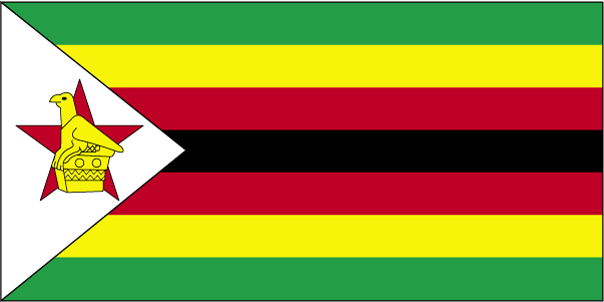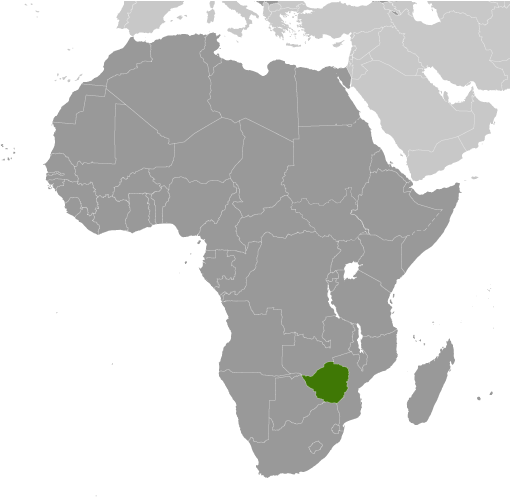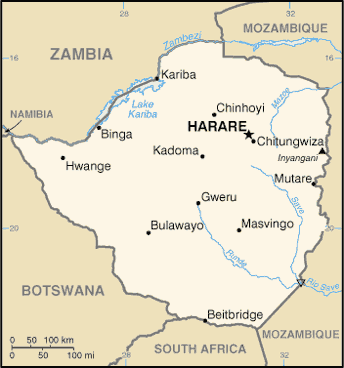|
Economy - overview:
|

|
|
Zimbabwe's economy is growing despite continuing political uncertainty. Following a decade of contraction from 1998 to 2008, Zimbabwe's economy recorded real growth of more than 9% per year in 2010-11, before slowing to 5% in 2012, due in part to a poor harvest and low diamond revenues. However, the government of Zimbabwe still faces a number of difficult economic problems, including infrastructure and regulatory deficiencies, ongoing indigenization pressure, policy uncertainty, a large external debt burden, and insufficient formal employment. Zimbabwe's 1998-2002 involvement in the war in the Democratic Republic of the Congo drained hundreds of millions of dollars from the economy. The government's subsequent land reform program, characterized by chaos and violence, badly damaged the commercial farming sector, the traditional source of exports and foreign exchange and the provider of 400,000 jobs, turning Zimbabwe into a net importer of food products. Until early 2009, the Reserve Bank of Zimbabwe routinely printed money to fund the budget deficit, causing hyperinflation. Dollarization in early 2009 - which allowed currencies such as the Botswana pula, the South Africa rand, and the US dollar to be used locally - ended hyperinflation and reduced inflation to about 10%, but exposed structural weaknesses that continue to inhibit broad-based growth.
|
|
|
GDP (purchasing power parity):
|

|
|
$6.909 billion (2012 est.)
country comparison to the world: 160
$6.579 billion (2011 est.)
$6.015 billion (2010 est.)
note:
data are in 2012 US dollars
|
|
|
GDP (official exchange rate):
|

|
|
$10.8 billion
note:
in 2009, the Zimbabwean dollar was taken out of circulation, making Zimbabwe's GDP at the official exchange rate a highly inaccurate statistic (2012 est.)
|
|
|
GDP - real growth rate:
|

|
|
5% (2012 est.)
country comparison to the world: 61
9.4% (2011 est.)
9.6% (2010 est.)
|
|
|
GDP - per capita (PPP):
|

|
|
$500 (2012 est.)
country comparison to the world: 228
$500 (2011 est.)
$500 (2010 est.)
note:
data are in 2012 US dollars
|
|
|
GDP - composition by sector:
|

|
|
agriculture: 20.3%
industry:
25.1%
services:
54.6% (2012 est.)
|
|
|
Labor force:
|

|
|
3.909 million (2012 est.)
country comparison to the world: 93
|
|
|
Labor force - by occupation:
|

|
|
agriculture: 66%
industry:
10%
services:
24% (1996)
|
|
|
Unemployment rate:
|

|
|
95% (2009 est.)
country comparison to the world: 202
80% (2005 est.)
note:
figures reflect underemployment; true unemployment is unknown and, under current economic conditions, unknowable
|
|
|
Population below poverty line:
|

|
|
68% (2004)
|
|
|
Household income or consumption by percentage share:
|

|
|
lowest 10%: 2%
highest 10%:
40.4% (1995)
|
|
|
Distribution of family income - Gini index:
|

|
|
50.1 (2006)
country comparison to the world: 23
50.1 (1995)
|
|
|
Investment (gross fixed):
|

|
|
21.9% of GDP (2012 est.)
country comparison to the world: 74
|
|
|
Budget:
|

|
|
revenues: $NA
expenditures:
$NA (2010 est.)
|
|
|
Taxes and other revenues:
|

|
|
NA% of GDP (2010 est.)
|
|
|
Budget surplus (+) or deficit (-):
|

|
|
NA% of GDP
|
|
|
Public debt:
|

|
|
202.7% of GDP (2012 est.)
country comparison to the world: 2
219.7% of GDP (2011 est.)
|
|
|
Inflation rate (consumer prices):
|

|
|
8.3% (2012 est.)
country comparison to the world: 183
5.4% (2011 est.)
|
|
|
Central bank discount rate:
|

|
|
7.17% (31 December 2010 est.)
country comparison to the world: 1
975% (31 December 2007)
|
|
|
Commercial bank prime lending rate:
|

|
|
30% (31 December 2012 est.)
country comparison to the world: 5
34% (31 December 2011 est.)
|
|
|
Stock of narrow money:
|

|
|
$12.28 billion (31 December 2012 est.)
country comparison to the world: 73
$6.586 billion (31 December 2011 est.)
note:
Zimbabwe's central bank no longer publishes data on monetary aggregates, except for bank deposits, which amounted to $2.1 billion in November 2010; the Zimbabwe dollar stopped circulating in early 2009; since then, the US dollar and South African rand have been the most frequently used currencies; there are no reliable estimates of the amount of foreign currency circulating in Zimbabwe
|
|
|
Stock of broad money:
|

|
|
$22.71 billion (31 December 2012 est.)
country comparison to the world: 82
$11 billion (31 December 2011 est.)
|
|
|
Stock of domestic credit:
|

|
|
$9.852 billion (31 December 2012 est.)
country comparison to the world: 99
$6.289 billion (31 December 2011 est.)
|
|
|
Market value of publicly traded shares:
|

|
|
$10.9 billion (31 December 2011)
country comparison to the world: 70
$11.48 billion (31 December 2010)
$3.83 billion (31 December 2009)
|
|
|
Agriculture - products:
|

|
|
corn, cotton, tobacco, wheat, coffee, sugarcane, peanuts; sheep, goats, pigs
|
|
|
Industries:
|

|
|
mining (coal, gold, platinum, copper, nickel, tin, diamonds, clay, numerous metallic and nonmetallic ores), steel; wood products, cement, chemicals, fertilizer, clothing and footwear, foodstuffs, beverages
|
|
|
Industrial production growth rate:
|

|
|
5.7% (2011 est.)
country comparison to the world: 54
|
|
|
Current account balance:
|

|
|
-$521.9 million (2012 est.)
country comparison to the world: 96
-$621.5 million (2011 est.)
|
|
|
Exports:
|

|
|
$3.314 billion (2012 est.)
country comparison to the world: 129
$2.932 billion (2011 est.)
|
|
|
Exports - commodities:
|

|
|
platinum, cotton, tobacco, gold, ferroalloys, textiles/clothing
|
|
|
Exports - partners:
|

|
|
South Africa 17.3%, China 16.9%, Democratic Republic of the Congo 11.7%, Botswana 10.5%, Italy 6.1% (2011)
|
|
|
Imports:
|

|
|
$4.675 billion (2012 est.)
country comparison to the world: 132
$4.37 billion (2011 est.)
|
|
|
Imports - commodities:
|

|
|
machinery and transport equipment, other manufactures, chemicals, fuels, food products
|
|
|
Imports - partners:
|

|
|
South Africa 55.4%, China 9.2% (2011)
|
|
|
Reserves of foreign exchange and gold:
|

|
|
$422 million (31 December 2012 est.)
country comparison to the world: 149
$461 million (31 December 2011 est.)
|
|
|
Debt - external:
|

|
|
$6.975 billion (31 December 2012 est.)
country comparison to the world: 101
$6.43 billion (31 December 2011 est.)
|
|
|
Stock of direct foreign investment - at home:
|

|
|
$NA
|
|
|
Stock of direct foreign investment - abroad:
|

|
|
$NA
|
|
|
Exchange rates:
|

|
|
Zimbabwean dollars (ZWD) per US dollar -
234.25 (2010)
234.25 (2009)
9,686.8 (2007)
note:
the dollar was adopted as a legal currency in 2009; since then the Zimbabwean dollar has experienced hyperinflation and is essentially worthless
|
|
|
Fiscal year:
|

|
|
calendar year
|
|
|
|





 )
)



